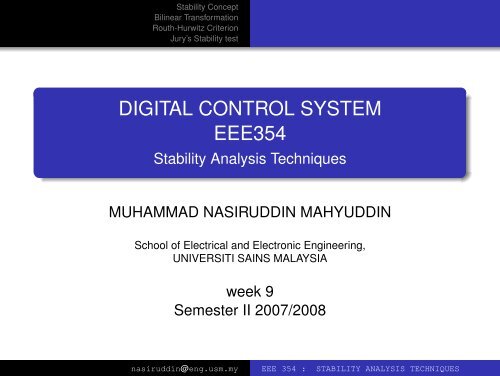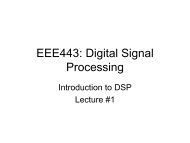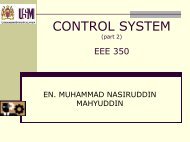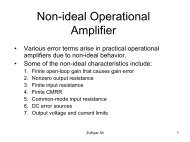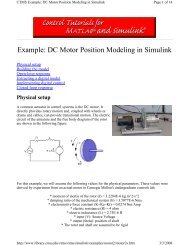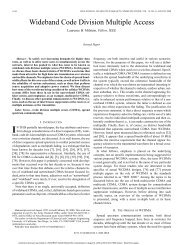Lecture notes - School Of Electrical & Electronic Engineering - USM
Lecture notes - School Of Electrical & Electronic Engineering - USM
Lecture notes - School Of Electrical & Electronic Engineering - USM
Create successful ePaper yourself
Turn your PDF publications into a flip-book with our unique Google optimized e-Paper software.
Stability Concept<br />
Bilinear Transformation<br />
Routh-Hurwitz Criterion<br />
Jury’s Stability test<br />
DIGITAL CONTROL SYSTEM<br />
EEE354<br />
Stability Analysis Techniques<br />
MUHAMMAD NASIRUDDIN MAHYUDDIN<br />
<strong>School</strong> of <strong>Electrical</strong> and <strong>Electronic</strong> <strong>Engineering</strong>,<br />
UNIVERSITI SAINS MALAYSIA<br />
week 9<br />
Semester II 2007/2008<br />
nasiruddin@eng.usm.my EEE 354 : STABILITY ANALYSIS TECHNIQUES
Outline<br />
Stability Concept<br />
Bilinear Transformation<br />
Routh-Hurwitz Criterion<br />
Jury’s Stability test<br />
week 9: 11/2/2008 - 15/2/2008<br />
1 Stability Concept<br />
Introduction: Stability Concept in Digital Control System<br />
2 Bilinear Transformation<br />
Definition<br />
Application of Bilinear Transformation<br />
3 Routh-Hurwitz Criterion<br />
Steps taken before using RH criterion<br />
4 Jury’s Stability test<br />
no need to do bilinear transformation<br />
Jury’s Stability Criterion<br />
nasiruddin@eng.usm.my EEE 354 : STABILITY ANALYSIS TECHNIQUES
Stability Concept<br />
Bilinear Transformation<br />
Routh-Hurwitz Criterion<br />
Jury’s Stability test<br />
Introduction to Stability Concept<br />
Introduction: Stability Concept in Digital Control System<br />
Generally, the stability analysis techniques applicable to LTI<br />
continuous-time systems may also be applied to the analysis of<br />
LTI discrete time systems, if certain modifications are made.<br />
These techniques include:-<br />
Routh-Hurwitz criterion<br />
root-locus procedures<br />
frequency response method such as:-<br />
bode plot<br />
nichols chart<br />
nasiruddin@eng.usm.my EEE 354 : STABILITY ANALYSIS TECHNIQUES
Stability Concept<br />
Bilinear Transformation<br />
Routh-Hurwitz Criterion<br />
Jury’s Stability test<br />
Introduction to Stability Concept<br />
Introduction: Stability Concept in Digital Control System<br />
Consider the following closed-loop pulse transfer function<br />
system:<br />
C(z)<br />
R(z) =<br />
G(z)<br />
1+GH(z)<br />
The stability of the system defined by the above equation may<br />
be determined from the locations of the closed loop in the<br />
z-plane, or the roots of the characteristic equation:<br />
P(z) = 1 + GH(z)<br />
nasiruddin@eng.usm.my EEE 354 : STABILITY ANALYSIS TECHNIQUES
Stability Concept<br />
Bilinear Transformation<br />
Routh-Hurwitz Criterion<br />
Jury’s Stability test<br />
Introduction to Stability Concept<br />
Introduction: Stability Concept in Digital Control System<br />
1 For the system to be stable, the closed-poles or the roots of the<br />
characteristic equation must lie within the unit circle in the<br />
z-plane.<br />
2 The system become critically stable if a simple pole lies at z=1<br />
or a single pair of conjugate complex poles lies on the unit circle<br />
in the z-plane.<br />
3 Any multiple closed-pole on the unit circle makes the system<br />
unstable<br />
4 Closed-loop zero do not affect the absolute stability and<br />
therefore may be located anywhere in the z-plane<br />
nasiruddin@eng.usm.my EEE 354 : STABILITY ANALYSIS TECHNIQUES
Stability Concept<br />
Bilinear Transformation<br />
Routh-Hurwitz Criterion<br />
Jury’s Stability test<br />
Definition of bilinear transformation<br />
Definition<br />
Application of Bilinear Transformation<br />
The bilinear transformation is defined by:<br />
Solving for w, gives:<br />
z = w+1<br />
w−1<br />
w = z+1<br />
z−1<br />
The transformation maps the interior of the unit circle in the z-plane<br />
into the left-half of the w plane.<br />
nasiruddin@eng.usm.my EEE 354 : STABILITY ANALYSIS TECHNIQUES
mapping of z-plane<br />
Stability Concept<br />
Bilinear Transformation<br />
Routh-Hurwitz Criterion<br />
Jury’s Stability test<br />
Definition<br />
Application of Bilinear Transformation<br />
Figure 1 below shows the mapping of the unit circle in the<br />
z-plane onto the imaginary axis of the w-plane.<br />
Figure 1: mapping of the unit circle in two planes<br />
nasiruddin@eng.usm.my EEE 354 : STABILITY ANALYSIS TECHNIQUES
Stability Concept<br />
Bilinear Transformation<br />
Routh-Hurwitz Criterion<br />
Jury’s Stability test<br />
bilinear transformation<br />
Definition<br />
Application of Bilinear Transformation<br />
Once the characteristic equation P(z) = 0 of the digital system<br />
is obtained, w = z+1<br />
z−1<br />
is substituted for z in the characteristic<br />
equation as follows:<br />
P(z) = a 0 z n + a 1 z n−1 + a 2 z n−2 + · · · + a n−1 z + a n = 0 (1)<br />
nasiruddin@eng.usm.my EEE 354 : STABILITY ANALYSIS TECHNIQUES
Stability Concept<br />
Bilinear Transformation<br />
Routh-Hurwitz Criterion<br />
Jury’s Stability test<br />
bilinear transformation I<br />
Definition<br />
Application of Bilinear Transformation<br />
The characteristic equation in w -domain then becomes:<br />
P(w) = a 0<br />
[ w + 1<br />
w − 1<br />
. . . +a n−1<br />
[ w + 1<br />
w − 1<br />
] n [ w + 1<br />
+ a 1<br />
w − 1<br />
] n−1 [ ] w + 1 n−2<br />
+ a 2 +<br />
w − 1<br />
]<br />
+ a n = 0 (2)<br />
P(w) = b 0 w n + b 1 w n−1 + · · · + b n−1 w + b n = 0 (3)<br />
nasiruddin@eng.usm.my EEE 354 : STABILITY ANALYSIS TECHNIQUES
Stability Concept<br />
Bilinear Transformation<br />
Routh-Hurwitz Criterion<br />
Jury’s Stability test<br />
bilinear transformation<br />
Definition<br />
Application of Bilinear Transformation<br />
The bilinear transformation transforms the z- plane into w plane. The<br />
frequency response of G(z) is G(jω), that is, by replacing z with jω.<br />
Equivalently, for w plane, the frequency response of replaced by a<br />
fictitious frequency jv .<br />
The relationship between the fictitious frequency and the desired<br />
frequency v can be obtained as follows:<br />
w∣ = z−1 ∣<br />
w=jv<br />
z+1<br />
∣<br />
z=e jωT<br />
jv = j tan ωT<br />
2<br />
v = tan ωT<br />
2<br />
nasiruddin@eng.usm.my EEE 354 : STABILITY ANALYSIS TECHNIQUES
Stability Concept<br />
Bilinear Transformation<br />
Routh-Hurwitz Criterion<br />
Jury’s Stability test<br />
Definition<br />
Application of Bilinear Transformation<br />
Application of Bilinear transformation I<br />
For stability analysis using frequency methods, such as the Bode<br />
diagram technique, another practical version of w- transformation was<br />
proposed:<br />
w ′ = 2 T w<br />
w ′ = 2 T<br />
z − 1<br />
z + 1<br />
where T is the sampling period. This implies that,<br />
(4)<br />
z = 1 + T 2 w′<br />
1 − T 2 w′ =<br />
2<br />
T + w′<br />
2<br />
T − w′ (5)<br />
nasiruddin@eng.usm.my EEE 354 : STABILITY ANALYSIS TECHNIQUES
Stability Concept<br />
Bilinear Transformation<br />
Routh-Hurwitz Criterion<br />
Jury’s Stability test<br />
Definition<br />
Application of Bilinear Transformation<br />
Application of bilinear transformation<br />
The w ′ -transformation is a bilinear transformation scaled with the<br />
factor of T 2 .<br />
The relationship between the actual/desired frequency ω and the<br />
fictitious frequency v ′<br />
is:<br />
v ′<br />
= 2 ( ) ωT<br />
T tan 2<br />
(6)<br />
(7)<br />
nasiruddin@eng.usm.my EEE 354 : STABILITY ANALYSIS TECHNIQUES
Stability Concept<br />
Bilinear Transformation<br />
Routh-Hurwitz Criterion<br />
Jury’s Stability test<br />
Routh- Hurwitz Criterion<br />
Steps taken before using RH criterion<br />
The Routh-Hurwitz criterion cannot be applied directly to the<br />
z-domain since the stability boundary is now different. The<br />
method requires transformation from z-plane to another plane,<br />
the w plane.<br />
Once the characteristic equation P(z) = 0 is transformed into a<br />
polynomial of the same order in w : P(w) = 0, the R-H criterion<br />
can then be applied directly as in the case of continuous data<br />
system.<br />
nasiruddin@eng.usm.my EEE 354 : STABILITY ANALYSIS TECHNIQUES
Stability Concept<br />
Bilinear Transformation<br />
Routh-Hurwitz Criterion<br />
Jury’s Stability test<br />
Routh-Hurwitz Criterion<br />
Steps taken before using RH criterion<br />
Worked Examples on<br />
Routh-Hurwitz Criterion<br />
nasiruddin@eng.usm.my EEE 354 : STABILITY ANALYSIS TECHNIQUES
Jury’s Stability Test<br />
Stability Concept<br />
Bilinear Transformation<br />
Routh-Hurwitz Criterion<br />
Jury’s Stability test<br />
no need to do bilinear transformation<br />
Jury’s Stability Criterion<br />
Let the CE P(z) = 0 of a digital system given in polynomial of z:<br />
P(z) = a n z n + a n−1 z n−1 + a n−2 z n−2 + · · · + a 2 z 2 + a 1 z + a 0 = 0 (8)<br />
where a n > 0 or it can be made positive by changing the sign of all the<br />
coeffecients, and a i , are real coeffecients.<br />
nasiruddin@eng.usm.my EEE 354 : STABILITY ANALYSIS TECHNIQUES
Jury’s Stability Test<br />
Stability Concept<br />
Bilinear Transformation<br />
Routh-Hurwitz Criterion<br />
Jury’s Stability test<br />
no need to do bilinear transformation<br />
Jury’s Stability Criterion<br />
In applying the Jury’s stability test, a Jury Stability table must<br />
first be constructed as shown in Table 1<br />
Table 1: Jury’s Table<br />
row z 0 z 1 z 2 z 3 . . . z n−1 z n−1 z n<br />
1 a 0 a 1 a 2 a 3 . . . a n−2 a n−1 a n<br />
2 a n a n−1 a n−2 a 2 . . . a 1 a 0<br />
3 b 0 b 1 b 2 b 3 . . . b n−2 b n−1 b n<br />
4 b n b n−1 b n−2 b n−3 . . . b 2 b 1 b 0<br />
2n-5 p 0 p 1 p 2 p 3 . . .<br />
2n-4 p 3 p 2 p 1 p 0 . . .<br />
2n-3 q 0 q 1 q 2<br />
nasiruddin@eng.usm.my EEE 354 : STABILITY ANALYSIS TECHNIQUES
Stability Concept<br />
Bilinear Transformation<br />
Routh-Hurwitz Criterion<br />
Jury’s Stability test<br />
Method to construct Jury’s Table<br />
no need to do bilinear transformation<br />
Jury’s Stability Criterion<br />
The Jury’s table is constructed as follows:<br />
1 The table consists of (2n − 3) rows. For second-order system,<br />
the table has only 1 row.<br />
2 The first row: the elements consist of the coeffecients in P(z)<br />
arranged in the ascending order of powers in z<br />
3 The second row: the elements consist of the coeffecients of P(z)<br />
arranged in the descending order of powers in z<br />
nasiruddin@eng.usm.my EEE 354 : STABILITY ANALYSIS TECHNIQUES
Stability Concept<br />
Bilinear Transformation<br />
Routh-Hurwitz Criterion<br />
Jury’s Stability test<br />
no need to do bilinear transformation<br />
Jury’s Stability Criterion<br />
The elements of rows 3 through (2n − 3) are given by the<br />
following determinants:<br />
b k =<br />
c k =<br />
d k =<br />
q 0 =<br />
∣ a ∣<br />
0 a n−k ∣∣∣<br />
, k = 0, 1, 2, . . . , n − 1. (9)<br />
a n a k ∣ b 0 b n−1−k ∣∣∣<br />
∣<br />
, k = 0, 1, 2, . . . , n − 2. (10)<br />
b n−1 b k ∣ c 0 c n−2−k ∣∣∣<br />
∣<br />
, k = 0, 1, 2, . . . , n − 3. (11)<br />
c n−2 c k ∣ p ∣ 0 p 3 ∣∣∣ , q<br />
p 3 p 2 =<br />
0<br />
∣ p ∣<br />
0 p 1 ∣∣∣<br />
(12)<br />
p 3 p 2<br />
nasiruddin@eng.usm.my EEE 354 : STABILITY ANALYSIS TECHNIQUES
Jury’s stability test<br />
Stability Concept<br />
Bilinear Transformation<br />
Routh-Hurwitz Criterion<br />
Jury’s Stability test<br />
no need to do bilinear transformation<br />
Jury’s Stability Criterion<br />
1 The elements in any even-numbered row ( row 2,4, . . . )<br />
are simply the reverse of the immediately preceding<br />
odd-numbered row ( row 1,3, . . . )<br />
2 The last row (row 2n − 3) has 3 elements.<br />
nasiruddin@eng.usm.my EEE 354 : STABILITY ANALYSIS TECHNIQUES
Stability Concept<br />
Bilinear Transformation<br />
Routh-Hurwitz Criterion<br />
Jury’s Stability test<br />
Jury’s Stability Criterion<br />
no need to do bilinear transformation<br />
Jury’s Stability Criterion<br />
The stability criterion by the Jury’s Stability Test: For the<br />
polynomial P(z) to have no roots on and outside the unit circle<br />
in the z-plane (i.e. for the digital or discrete data system to be<br />
stable), the following conditions must be satisfied:<br />
a) P(z)| z=1 = P(1) > 0 (13)<br />
{ > 0 for n even<br />
b) P(z)| z=−1 = P(−1)<br />
< 0 for n odd<br />
(14)<br />
nasiruddin@eng.usm.my EEE 354 : STABILITY ANALYSIS TECHNIQUES
Stability Concept<br />
Bilinear Transformation<br />
Routh-Hurwitz Criterion<br />
Jury’s Stability test<br />
Jury’s Stability Criterion<br />
no need to do bilinear transformation<br />
Jury’s Stability Criterion<br />
c)<br />
|a 0 | < |a n |<br />
|b 0 | > |b n−1 |<br />
|c 0 | > |c n−2 |<br />
|d 0 | > |d n−3 |<br />
.<br />
|q 0 | > |q 2 |<br />
}<br />
(n − 1) constraints (15)<br />
nasiruddin@eng.usm.my EEE 354 : STABILITY ANALYSIS TECHNIQUES
Stability Concept<br />
Bilinear Transformation<br />
Routh-Hurwitz Criterion<br />
Jury’s Stability test<br />
Jury’s Stability Criterion<br />
no need to do bilinear transformation<br />
Jury’s Stability Criterion<br />
For example, a second-order system would have n = 2.<br />
Therefore, Jury’s stability table contains only 1 row. Thus, for<br />
stability:<br />
P(1) > 0<br />
P(−1) > 0 (16)<br />
|a 0 | < |a 2 |<br />
(17)<br />
nasiruddin@eng.usm.my EEE 354 : STABILITY ANALYSIS TECHNIQUES
DIGITAL CONTROL SYSTEM EEE354<br />
(Sistem Kawalan Digit)<br />
Worked Examples<br />
prepared by Nasiruddin ∗<br />
semester II 2007/2008<br />
1 Example on Routh Hurwitz<br />
Criterion<br />
By using Routh-Hurwitz stability criterion, determine<br />
the stability of the following digital systems<br />
whose characteristic are given as:<br />
a) z 2 − 0.25 = 0<br />
b) z 3 − 1.2z 2 − 1.375z − 0.25<br />
1.1 Solution to Example 1(a)<br />
Transforming the characteristic equation z 2 − 0.25 =<br />
0 into w-domain by using the bilinear transformation<br />
z = w+1<br />
w−1 , gives:<br />
0.75w 2 + 2.5w + 0.75 = 0 (1)<br />
It can be observed that all the coeffecients are of the<br />
same sign, and none of the coeffecients is zero. Thus,<br />
all the roots of the tranformed equation 1 are in the<br />
left-half of the w-plane. Hence, all the roots of the<br />
∗ Muhammad Nasiruddin Mahyuddin (Mechatronic Programme,<br />
<strong>School</strong> <strong>Of</strong> <strong>Electrical</strong> and <strong>Electronic</strong> <strong>Engineering</strong>, <strong>USM</strong>)<br />
characteristic equation in the z-domain are inside the<br />
unit-circle in the z-plane.<br />
Thus, the system is stable.<br />
1.2 Solution to Example 1(b)<br />
Transforming the characteristic equation z 3 −1.2z 2 −<br />
1.375z −0.25 = 0 into w-domain by using the bilinear<br />
transformation z = w+1<br />
w−1 , gives:<br />
− 1.875w 3 + 3.875w 2 + 4.875w + 1.125 = 0 (2)<br />
Based on the transformed CE, the Routh tabulation<br />
is constructed as follows:<br />
w 3 -1.875 4.875<br />
w 2 3.875 1.125<br />
w 1 5.419 0<br />
w 0 1.125<br />
From the table above, since there is one sign change<br />
in the first column, equation 2 has one root in the<br />
right-half of the w-plane. This, in turn, implies that<br />
there will be one root of the characteristic equation<br />
outside of the unit circle in the z-plane.<br />
1
Thus, the system is not stable.<br />
1.3 Example 2<br />
By using RH criterion, determine the stability of a<br />
digital system whose CE is given as P (z) = z 3 +<br />
3.3z 2 + 3z + 0.8 = 0.<br />
1.3.1 Solution to Example 2<br />
Transforming the CE P (z) into w-domain by using<br />
bilinear transformation z = w+1<br />
w−1 , gives:<br />
8.1w 3 + 0.9w 2 − 0.9w − 0.1 = 0 (3)<br />
The RH tabulation for the transformed CE 3 is as<br />
follows:<br />
w 3 8.1 -0.9<br />
w 2 0.9 -0.1<br />
w 1 0 0<br />
w 0<br />
The routh test could not be continued in the usual<br />
manner since row w 1 contains all zeros. The tabulation<br />
is proceeded by the auxillary equation from the<br />
coeffecients in the w 2 row:<br />
A(w) = 0.9w 2 − 0.1 = 0 (4)<br />
Taking the derivative of A(w) in equation 4 with<br />
respect to w , gives:<br />
A(w)<br />
dw<br />
= 1.8w (5)<br />
The coeffecient in the w 1 row are then filled with<br />
A(w)<br />
the coeffecient of<br />
dw<br />
, and the Routh tabulation<br />
then becomes:<br />
w 3 8.1 -0.9<br />
w 2 0.9 -0.1<br />
w 1 1.8 0<br />
w 0 -0.1<br />
From the Routh table, it can be see that there is<br />
one sign change, which implies that the CE has one<br />
root in the right half of the w-plane, or P (z) has one<br />
root outside the unit circle in the z-plane.<br />
1.4 Example 3<br />
By using Routh-Hurwitz stability criterion, determine<br />
the range of the gain K and the sampling period<br />
T, so that the digital system whose CE is given as<br />
P (z) = z 3 + a 2 z 2 + a 1 z + a 0 is asymptotically stable.<br />
The coeffecients of the CE are as follows:<br />
a 2 = 111.6T 2 + 16.74T − 3 (6)<br />
a 1 = 1.395 ∗ 10 −4 KT 3 − 33.48T + 3 (7)<br />
a 0 = 1.395 ∗ 10 −4 KT 3<br />
− 16.74T − 111.6T 3 − 1 (8)<br />
1.4.1 Solution to example 3<br />
Transforming the CE P(z) into w-domain by using<br />
the bilinear transformation z = w+1<br />
w−1 , gives<br />
where,<br />
A 3 w 3 + A 2 w 2 + A 1 w + A 0 = 0, (9)<br />
A 3 = a 2 + a 1 + a 0 + 1 = 2.79 ∗ 10 −4 KT 3 (10)<br />
A 2 = a 2 − a 1 + 3a 0 + 3 = 446.4T 2<br />
− 5.58 ∗ 10 −4 KT 3 (11)<br />
A 1 = −446.4T 2 + 66.96T<br />
+ 2.79 ∗ 10 −4 KT 3 (12)<br />
A 0 = −a 2 + a 1 − a 0 + 1 = 8 − 66.96T (13)<br />
2
The routh tabulation for the transformed CE will<br />
be:<br />
w 3 A 3 A 1<br />
w 2 A 2 A 0<br />
w 1<br />
A1A2−A0A3<br />
A 2<br />
w 0 A 0<br />
For stability, all the coffecients in the first column<br />
must be of the same sign, Thus from,<br />
w 0 : A 0 = 8 − 66.96T > 0. ⇒ T < 0.1195(14)<br />
w 1 : A 1 A 2 − A 0 A 3 > 0.<br />
⇒ −15.568 ∗ 10 −8 T 3 K 2<br />
+ (0.3736T 2 − 0.01868T − 0.002232)K<br />
+ (29890.94 − 199272.96T ) > 0 (15)<br />
w 2 : A 2 = 446.4T 2 − 5.58 ∗ 10 −4 KT 3 > 0.<br />
⇒ K < 800000/T. (16)<br />
w 3 : A 3 = 2.79 ∗ 10−4KT 3 > 0. (17)<br />
Thus, the stability of the system is controlled by<br />
the four inequality conditions above. Hence, the<br />
ranges of T and K for stability can be written as<br />
follows:<br />
2 Example on Jury’s Stability<br />
Test<br />
2.1 solution using Jury’s Stability<br />
Test<br />
By using question from example 1(a), we can solve<br />
using Jury’s stability test,<br />
(a) The equation P (z) = z 2 − 0.25 = 0 is of second<br />
order. Under the Jury’s Stability test, for the system<br />
to be stable, the necessary condition must be satisfied<br />
according to Table 2.4:<br />
Table 1: Jury’s Table<br />
Conditions System satisfied<br />
or not<br />
1 P (1) > 0 P (1) = 1 − 0.25 = 0.75 > 0 satisfied<br />
2 P (−1) > 0 P (−1) = 1 − 0.25 = 0.75 > 0 satisfied<br />
3 |a 0 | < a 2 |a 0 | = 0.25 < a 2 = 1 satisfied<br />
Since all the conditions are satisfied, the system<br />
is stable.<br />
2.2 Example 2<br />
Determine the stability of a discrete data system described<br />
by the following CE by using Jury’s Stability<br />
criterion.<br />
P (z) = z 3 − 1.2z 2 − 1.375z − 0.25 = 0<br />
0 < T < 0.1195<br />
0 < K < 800000/T<br />
−15.568 ∗ 10 −8 T 3 K 2<br />
+(0.3736T 2 − 0.01868T − 0.002232)K<br />
+(29890.94 − 199272.96T ) > 0<br />
3
2.3 Solution to Example 2<br />
Under the Jury’s stability test for the system to be<br />
stable, the following three necessary conditions must<br />
be satisfied first:<br />
Table 2: Jury’s Table<br />
Conditions System satisfied<br />
1 P (1) > 0 P (1) = 1 − 1.2 − 1.375<br />
−0.25 = −1.875 > 0 not<br />
2 P (−1) < 0 P (−1) = −1 − 1.2<br />
or not<br />
satisfied<br />
+1.375 − 0.25 = −1.125 > 0 satisfied<br />
3 |a 0 | < a 3 |a 0 | = 0.25 < a 3 = 1 satisfied<br />
Since the first condition is not satisfied, the system<br />
is not stable.<br />
2.4 Example 3<br />
Determine the stability of a discrete data system described<br />
by the following CE by using Jury’s stability<br />
criterion.<br />
P (z) = z 3 + 3.3z 2 + 4z + 0.8 = 0<br />
Solution to Example 3<br />
Under the Jury’s stability test, for the system to<br />
be stable, the following three necessary conditions<br />
must be satisfied first:<br />
All the necessary conditions are satisfied, thus we<br />
have to carry out the Jury tabulation to determine<br />
the stability of the system as follows:<br />
where<br />
b 0 =<br />
b 1 =<br />
b 2 =<br />
Table 4: Jury’s Table<br />
row z 0 z 1 z 2 z 3<br />
1 0.8 4.0 3.3 1.0<br />
2 1.0 3.3 4.0 0.8<br />
3 b 0 b 1 b 2<br />
∣ a ∣<br />
0 a 3 ∣∣∣<br />
= a 2<br />
a 3 a<br />
0 − a 2 3 = −0.36 (18)<br />
0 ∣ a ∣<br />
0 a 2 ∣∣∣<br />
= a<br />
a 3 a 0 a 1 − a 2 a 3 = −0.1 (19)<br />
1 ∣ a ∣<br />
0 a 1 ∣∣∣<br />
= a<br />
a 3 a 0 a 2 − a 1 a 3 = −1.36<br />
2<br />
(20)<br />
The sufficient condition for stability is |b 0 | > |b 2 |.<br />
Thus, it can be seen that from the values of b 0 and<br />
b 2 obtained, this condition is not satisfied.Hence, the<br />
system is not stable. In fact the roots are at z =<br />
−0.2463. − 1.5268 ± j0.9574.<br />
Table 3: Jury’s Table<br />
Conditions System satisfied<br />
or not<br />
1 P (1) > 0 P (1) = 1 + 3.3<br />
+4 + 0.8 = 9.1 satisfied<br />
2 P (−1) < 0 P (−1) = −1 + 3.3<br />
−4 + 0.8 = −0.9 satisfied<br />
3 |a 0| < a 3 |a 0| = 0.8 < a 3 = 1 satisfied<br />
4


